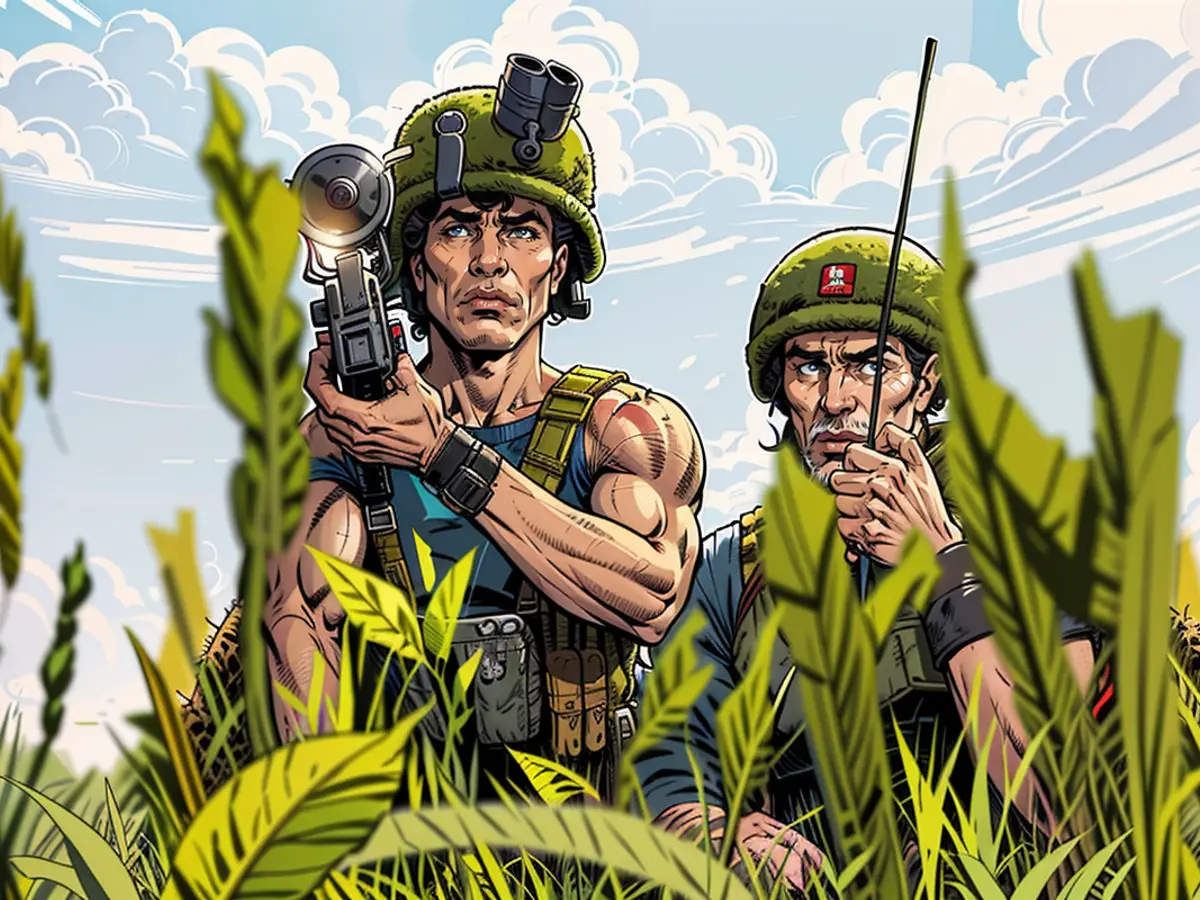In Kursk, a game of predator and prey unfolds.
In a coal mine situated within the Donbass region, an unfortunate incident led to the explosion of a conveyor tower. This unfortunate event has significantly benefited the Russians, giving them a strategic edge. The complexities surrounding Ukraine's ability to safeguard Pokrovsk, a currently contentious area in the Donbass, against invaders are discussed by Colonel Markus Reisner on ntv.de.
ntv.de: Colonel Reisner, there's been speculation about the Russian advance in the Donbass slowing down. At the same time, Ukraine reported 23 attacks on Pokrovsk over the weekend, making it the most contested region in the Donbass. With regards to the current proximity of the Russians to Pokrovsk, what can you share?
Colonel Reisner: The Russian forces are approximately 5 to 6 kilometers from Pokrovsk's city limits. While the immediate advance on Pokrovsk has slowed down at present, the Russians are not opting for a frontal attack. Instead, they are attempting to flank Pokrovsk from different directions. This leads to intense fighting in the Torez region, located north-east of Pokrovsk, while the danger of encirclement looms in two places to the south, threatening to trap Ukrainian troops.
ntv.de: So, this slowdown is not due to the Russians running out of strength?
Colonel Reisner: Contrary to belief, the Russians are still engaging in heavy combat. Each Russian attack can be categorized into multiple phases. First, they employ heavy artillery and rocket launchers to degrade Ukrainian positions by continuous bombardments. Second, they send reinforcements, usually consisting of small groups of infantry or assault troops, aiming to infiltrate the terrain.
ntv.de: By foot? So, these infantry troops are moving on foot?
Colonel Reisner: Yes, these reconnaissance groups progress on foot, making use of motorcycles to move swiftly, which are challenging targets for drones. With numerous drones in the air for both surveillance and attack, conventional vehicles such as combat or armored vehicles are easy to detect, increasing their vulnerability.
ntv.de: And if these light forces manage to advance far, what happens then?
Colonel Reisner: In this scenario, heavier forces are deployed in parallel, typically covering several kilometers, aiming to distract and divide the Ukrainian defenders. The Hochdruck-approach is designed to avoid the formation of a solid defense line by the Ukrainians, forcing them to split their efforts in the defense of various points of attack. This leads to a greater number of, for example, the 23 attacks mentioned at the outset. The advance of the light forces allows for the deployment of stronger combat elements. In this manner, the Russians progress steadily onwards.
ntv.de: But are they not directly advancing towards Pokrovsk?
Colonel Reisner: Upon expanding our view, we observe the frontline Russian advances to the east of Pokrovsk, which they successfully breached a few months ago.
ntv.de: So, the Russians are not attempting to extend this newly occupied area towards Pokrovsk but rather to broaden it towards the flanks?
Colonel Reisner: Correct, both north and south. Efforts are being made to introduce additional forces. Intense fighting has commenced in the northeast, near Torez, approximately 30 kilometers from Pokrovsk. Twenty kilometers southeast of the city, the Russians have formed a small enclave, which is easily discernible on current maps. Farther south, around Vuhledar, the Russians have managed to capture two coal mines, posing a threat to Ukrainian troops facing entrapment.
ntv.de: How significant are these captured mines?
Colonel Reisner: Extremely significant. The flat terrain in the region contains few opportunities for surreptitiously approaching the enemy. Windbreaks formed by trees and shrubs and small waterways are the only feasible options. The mines dominate the surrounding area, thanks to the artificial hills formed by mining activities and observation towers. The Ukrainians can leverage these advantages to monitor and control the surrounding area. Unfortunately, the Russians shared a video yesterday displaying the destruction of an observation tower near a mine northeast of Vuhledar by guided bombs.
ntv.de: So, the Russians have not entirely lost this advantage at Vuhledar?
Colonel Reisner: Not yet, but they have made it difficult for the Ukrainians to effectively defend the area. Vuhledar itself may eventually fall, as it is a mining town home to numerous workers. Footage from the frontline reveals the use of drones to destroy vehicles and soldiers, thereby revealing critical locations on the battlefield. These drone strikes indicate that despite the stiff resistance, the Russians are making steady progress, with the attack lines and front lines inexorably moving westward.
ntv.de: What's the situation in the Kursk area, where the Ukrainians have been holding Russian territory for several weeks?
Colonel Reisner: There, we observe a form of cat-and-mouse game, with roles reversed compared to the present situation in the Donbass. The Ukrainians have penetrated Russian territory and the Russians are targeting them on the flanks, attempting to push them back. The Ukrainians are persistently resisting. It's a cyclical situation.
ntv.de: Ukrainian President Volodymyr Zelenskyy announced over the weekend that he can only adequately equip four of the 14 brigades. Is this affecting all front sectors?
Sure, let's break this down and rephrase it:
The Ukrainian defensive measures in Kursk, Donbass, and Kharkiv regions are being impacted due to the ongoing situation. They require well-equipped units in these areas. Furthermore, this situation is affecting their strategic planning. Ukraine aims to launch another offensive next year, but they need fully prepared combat brigades equipped with tanks, armored vehicles, and artillery to make this possible. Unfortunately, a significant portion of the equipment used during the summer offensive has been destroyed, and many of the Abrams tanks and Leopard IIs sent have also been lost.
In the upcoming months, approximately 100 Leopard 1 tanks are expected to be delivered. How significant of an impact will this have on Ukraine?
Compared to the Leopard 2, the Leopard 1 is less powerful. Its technology is on par with Russian and Ukrainian systems from the 1970s and 1980s, with some improvements. If Ukraine wants to defend its current territory, they would need at least 300 tanks. However, if they aim to reclaim lost territories by 2025, they would need at least 3,000 tanks. As per the Ukrainian president, the support they are receiving is not enough for both defense against Russian attacks and for the planned offensive next year.
At the same time, Zelensky has been advocating for weeks to permit the use of long-range weapons from the West. These weapons could target enemy command stations, airfields, and infrastructure on Russian territory. Is this debate worth it? Would it have a noticeable impact?
Reports suggest that the Russians have already moved their combat aircraft to areas beyond the reach of ATACMS, long-range US missiles. They had ample time to prepare due to the lengthy discussions. While attacks on command centers, logistics facilities, and ammunition depots are feasible, the debate highlights a lack of unity in the West, which benefits Russia and is exploited by Russia. The Kremlin threatens nuclear weapon use, builds more threats, and succeeds in the information sphere. Meanwhile, Russia has used over 4,000 guided bombs, 300 cruise missiles, and hundreds of drones against Ukraine in the last month alone. According to Zelensky, already 80% of critical infrastructure has been damaged or destroyed.
Frauke Niemeyer spoke with Markus Reisner
Following Colonel Reisner's analysis, it's worth noting that the strategic advantage gained by Russia after the explosion of the coal mine in the Kursk area has played a crucial role in their current tactics. The Russians are utilizing the lessons learned from the Kursk incident to flank Pokrovsk from different directions, leading to intense fighting.
As the discussion regarding the delivery of Leopard 1 tanks continues, it's important to consider that even if these tanks are deployed, they might not offer the same level of firepower as needed to effectively defend or reclaim lost territories. The Ukrainian president has emphasized the need for more substantial support from the West, including the use of long-range weapons to target enemy infrastructure.









